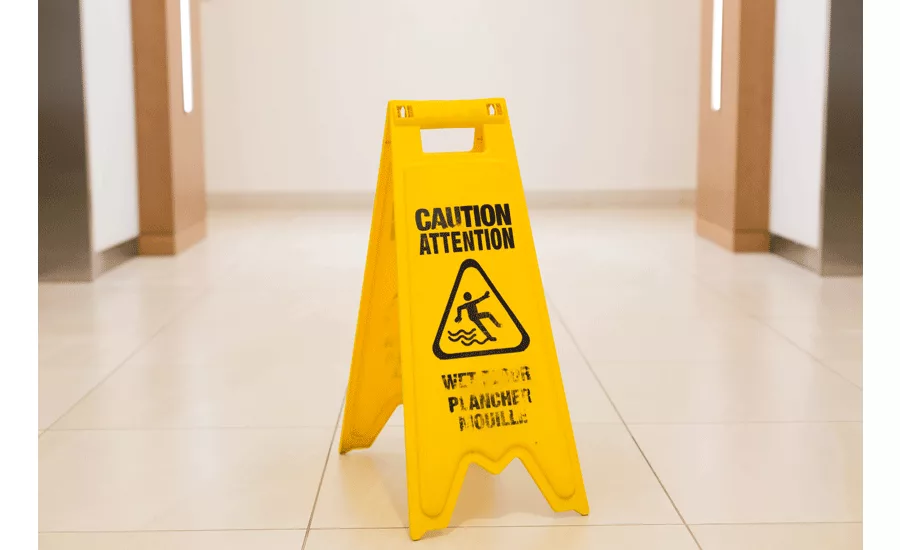Preventing slips, trips and falls in the plumbing industry

It’s no secret that health and safety is a big issue in the plumbing industry. Working on wet surfaces can often lead to the increased risk of slips, trips and falls. For you, that’s time out of work you don’t need, and for your employees, that’s liability you don’t want.
Slips, trips and falls account for 31% of all non-fatal injuries in the workplace. This is by far the highest percentage when it comes to the type of workplace accident.
Sufficient training is the first step in raising awareness about potential hazards at work. All workers should be educated on health and safety legislation, regulations as well as personal safety and the safety of others.
Wet areas and spillages aren’t the only hazards you need to consider when plumbing. In this guide, we will provide best practice advice for how to prevent and respond to slip, trip and fall hazards, avoiding injury and hefty pay-outs.
POTENTIAL INJURIES
Some of the injuries that can result from slipping and falling in a plumbing environment include: sprains or strains, broken bones, back injuries due to the impact, burns if the accident occurred near hot surfaces, and cuts if it occurs near sharp objects.
CAUSE AND EFFECT
As you would expect, slips occur when there is minimal to no grip between someone’s shoe and the floor. Trips happen when something goes unnoticed on the ground, i.e. a worker’s foot hits an object and knocks them off balance. Outlined below are some of the key slip and trip hazards to look out for when plumbing.
Wet surfaces: Wet surfaces are the most obvious danger to plumbers in their work environment. Due to the nature of the job, water is likely to end up on the floor frequently, and if combined with a smooth surface, presents itself as a prime slip risk.
In order to prevent slips on water spillages from happening, ensure co-workers are suitably informed of the wet areas and that the area is marked. Spills and wet areas should be mopped up as quickly as possible and never left unmarked or unattended.
Poor lighting: Plumbing often involves working in very tight, enclosed spaces. This means there is often low level or poor lighting in the work area. Poor lighting means obstacles and contaminants are more difficult to identify and spot. This can lead to slips, trips or falls.
To enhance poor lighting, make sure natural light isn’t being blocked and additional lighting equipment is being used without glare or shadowing to illuminate lower visibility areas.
Cluttered work areas: Work areas and walkways can be hazardous if tools and equipment are left carelessly on the ground. This can be especially dangerous in smaller and lower lit areas. It’s important workers get into the habit of keeping walkways and work areas clear of tools and equipment not currently in use.
Uneven flooring: Uneven areas or missing flooring is another likely occurrence plumbers experience on a frequent basis. Often, flooring needs to be lifted to access plumbing which can lead to dangerous openings in your work area. This means an accident is waiting to happen if the correct precautions have not been made.
To prevent accidents, it is important to secure flooring that is not currently laying flat where possible. Ensure that any missing or uneven areas of flooring are highlighted, marked and easily visible to all workers. This links back to the importance of well-lit work environments and good communication.
Inappropriate footwear: Wearing the right footwear is critical when working on the job. If they’re not suitable for the field, its putting health and safety at risk.
A non-slip outsole with appropriate tread is one of the most important features for plumbers, as this will give the grip you need on slick, potentially wet floors. They should be comfortable, fit correctly and be checked regularly to make sure treads have not worn down. If treads are worn away, they should be replaced as soon as possible.
OTHER THINGS YOU CAN DO
Aside from the advice provided here, there are some additional ways to further reduce the risk of tripping or slipping on a wet floor.
Workers should be encouraged to take their time when navigating their work area, adjusting their pace and stride suitable for the surface they are walking on. If the floor is wet and must be crossed, workers should walk slowly and carefully, wearing the appropriate safety footwear.
To avoid tripping on objects on the floor, remember to ensure anything you or your workers are carrying or moving does not obscure the view of your work environment ahead.
The article was produced by Rob White on behalf of CCL Wetrooms, the UK's leading wet room specialist for architect and house builders.
Looking for a reprint of this article?
From high-res PDFs to custom plaques, order your copy today!





